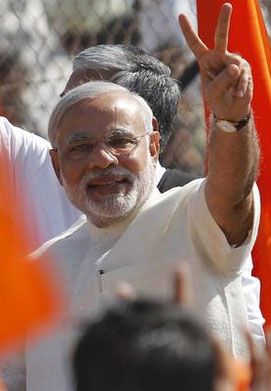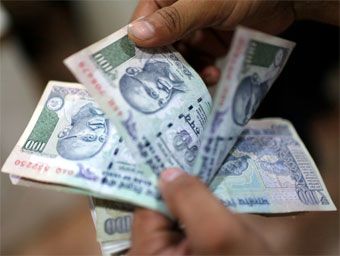With Narendra Modi about to make his first Independence Day speech, there is a buzz in Delhi that Modi will make some big announcements to signal major reforms and directional shifts. But we have to wait and see if it happens, says Mohan Guruswamy.
 Two and more months after the Modi government was installed in Delhi, a widespread feeling has begun to creep in, and mostly among the believers, that the regime has lost its way. And the weeds of the old polity have begun to blight the crop sowed with great expectations. The nature and direction of the first (Arun) Jaitley Budget only served to accentuate that feeling.
Two and more months after the Modi government was installed in Delhi, a widespread feeling has begun to creep in, and mostly among the believers, that the regime has lost its way. And the weeds of the old polity have begun to blight the crop sowed with great expectations. The nature and direction of the first (Arun) Jaitley Budget only served to accentuate that feeling.
With August 15 nearing and Narendra Modi about to make his first Independence Day speech to the country, there is a buzz in Delhi that with the nation’s attention fully focused on him, Modi will make some big announcements to signal major reforms and directional shifts. We have to wait and see.
But the item that is openly being talked about is a major initiative on greater financial inclusion. The first phase of this plan would be to bring in an additional 75 million households into the banking system. At present, India has about 310 million bank accounts.
According to the Census data, of a total of 192 million households in the country, only 68 million households or about 35.5 per cent avail of banking services. Of the 35 states and Union territories covered, only eight reported that banking services were available to more than half its households.
There are some surprises here as well. Tamil Nadu, which has the highest credit/deposit ratio in the country, has a penetration ratio of just 22.8 per cent while Bihar, which has the lowest credit/deposit ratio, has a penetration of 21.3 per cent. India’s wealthiest state (in terms of per capita income), Delhi, has coverage lower than that of Himachal, Punjab, Haryana and UP.
Relatively prosperous states like Maharashtra, Gujarat and Karnataka have a penetration rate of less than half. Clearly there is scope to do much better. Given this state of affairs, the target of 75 million is a huge effort.
There are many reasons why this becomes important, not the least being the direct transfer of benefits. An entirely new system of transferring subsidies to bypass the corrupt and very bureaucratic system can be contemplated with universal or near universal financial inclusion. Thus, instead of food subsidies supposedly being delivered by the public distribution system, a direct cash transfer will stem the hemorrhage that keeps people without benefits and angry at the State. With cash in hand a person can go out and buy food grains from the regular distribution chain. If this system is extended to the purchase of fertilisers and electricity we are looking at a system that could eliminate the many distortions in the economic system we have created.
I don’t think everyone in government is thinking that far ahead, but some certainly are. The first major step to a new and even cashless system is a universal coverage by banking services. This may not be as far-fetched as it may seem now. By the end of last year, nearly 314 million bank customers were issued debit cards. This number is growing at a compound annual rate of 18 per cent, and this pace is expected to be sustained, if not improved. With the focus on higher bank inclusion as many as 514 million bank customers or nearly half of India's population will be issued debit cards in the next three years.
Now think of this, India is the third largest economy in the world in PPP terms and it is predicted that by 2050 it will be a $30-55 trillion economy, depending on whose projections is music to your ears. 2050 is just 36 years from now and in a nations lifetime that is a mere wink. This is not daydreaming. In 1990-91, when PV Narasimha Rao initiated the first dismantling of the centrally planned State, the GDP of India at current US$ was a little over $200 billion. Twenty-three years later it is ten times that.
 We have more immediate reasons to speed up financial inclusion also. The savings/GDP ratio has sharply dropped from 38.1 per cent in 2008 to 30.1 per cent in 2012. This means a depletion of credit availability by as much as $200 billion or Rs 12 lakh crore.
We have more immediate reasons to speed up financial inclusion also. The savings/GDP ratio has sharply dropped from 38.1 per cent in 2008 to 30.1 per cent in 2012. This means a depletion of credit availability by as much as $200 billion or Rs 12 lakh crore.
The biggest drop has been in household savings, which has been slowing down by as much a 1.0 per cent a year. A high savings/GDP is essential if we have to maintain a high investment/GDP ratio. With investment slowing down, job creation and growth will inevitably slowdown. This is the economy’s single biggest challenge.
The other major reason for banks to bring in more financial inclusion is requirements of Credit Deposit Ratios. Lending our money to others for a profit is the bank's main business. But lending is also a risky business. In March 2014 as much as 4.6 per cent of all advances were deemed non-performing assets.
Gross NPAs of 40 listed banks shot up by 35.2 per cent or Rs 63,386 crore (Rs 633.86 billion) for the nine months ending December 2013 to cross the Rs 2.4 lakh crore mark. Ten out of the 40 listed banks accounted for nearly 70 per cent of the total gross NPAs of Rs 2.43 lakh crore. The State Bank of India at 28 per cent and Rs 67,799 crore (Rs 677.99 billion) have the largest share in the total gross NPAs.
The Reserve Bank of India has warned that there are chances that the NPA ratio could increase further to 5.5 per cent if macroeconomic conditions deteriorate. The stress tests indicated that under a severe stress scenario, gross NPAs for public sector banks might rise to 6.1 per cent by March 2015 from 4.6 per cent in March 2014. Clearly, Arun Jaitley has to be prepared for that possibility also.
At the time of writing this, the economy has shown some welcome signs of renewed growth. Industrial production is rising. Consumer demand is reviving. But prudence demands that we be prepared for any eventualities. The monsoon has largely played truant this year. The external situation continues to be troubled in the oil-producing region.
As per banking norms this means Indian banks, particularly the 14 government owned banks, are severely stressed. There are two ways to bring the banks to within prescribed stress levels. The first is to increase the capital base of the banks. To retain the current level of control the government has to bring in a huge Rs 90, 000 crore. The other way is to dress up the banks’ financials is to increase its deposit base. In reality, they need both as even to raise the deposit base the banks now need increased capitalisation. Greater financial inclusion, apart from its many systemic benefits, will also restore the health of the banking system.
India's huge mobile telephone network with over 900 million connections and growing, and IT prowess offer a ready and tested technology platform to make financial inclusion an ever bigger reality through a network of ATMs. Technology today offers us the means of banking services expansion without costly brick and mortar expansion, with attendant manpower costs.
The long reviled Aadhar card project, reviled most by the Bharatiya Janata Party, has now been adopted by the Modi government with great alacrity. This will make opening of new accounts a less herculean task than it is now. The next step in this roll-out could very well be a combination of Aadhar cum debit card with more advanced bio-metric identification. The Modi government has so far been emphasising that this is not an NDA or UPA contribution, but a national endeavour and achievement. And that too is a major bold new step.
As Dr Ram Manohar Lohia would say: "Abhi toh yeh angdayi hai, aage aur bhi ladayi hai (This is just the beginning, there are more struggles to be waged ahead.)"
Top image: Prime Minister Narendra Modi is expected to make some big announcements to signal major reforms and directional shifts in his Independence Day speech. Photograph: Reuters.










